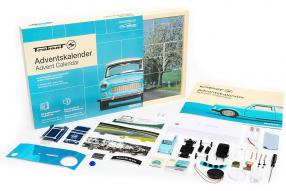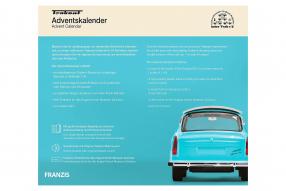Who doesn't know the history of the Berlin Wall, which was brought down on November 9th, 1989 and reunited Germany, which was divided into two parts. No car is identified with the former GDR as much as the Trabant, which is also affectionately known as the “Trabi”. The Trabant owes its name to a survey that was carried out when it was built. Trabant means something like “companion” or “companion”. Today, the Trabi has long since achieved cult status, even beyond the borders of Germany. Publisher Franzis, which is known for its automotive Christmas calendars, brings us the Trabi as a 24-day model building experience suitable for the run-up to Christmas. The calendar includes an eight-part kit, which when assembled results in a Trabant 601 in scale 1:43, and a high-quality plastic base that contains a sound module. In addition to several small surprises, this Advent calendar also contains a large-format manual by author Frank Rönicke and an entry ticket for the August Horch Museum in Zwickau. This set from Franzis ensures that the waiting time for Christmas Eve will fly by.
With a construction period of 33 years (1958-1991), the Trabi can be said to be a real long-running hit. When it was released, it was considered a modern small car that was intended to ensure mass mobility in the GDR. However, the quantities produced remained far behind the quantities demanded. This imbalance meant that hardly any further developments could be made to the vehicle and the Trabant, especially in terms of its appearance, remained almost unchanged throughout the entire construction period. Another effect of this imbalance was the fact that the waiting times for a new car were so long that even vehicles that were several years old could still be sold at the new price.
What was planned at the start of production as a GDR Volkswagen quickly turned into a symbol of the stagnation of the GDR economy. After the fall of the Wall and the falling demand for products from the East, the price of the Trabi also fell. At that time, it was often enough to exchange a case of beer or a bottle of wine to purchase the small car with the thermoset body. The logical prognosis at the beginning of the 1990s was that the Trabi would die out. It looked like that for a long time. While 900,000 vehicles were registered in Germany in 1993, in 2015 there were just over 32,000 vehicles. However, we are now experiencing the phenomenon that the number of registrations exceeds the number of unsubscriptions. In 2019 there were just over 36,000 registered vehicles in Germany. In 2021 the number rose further to just over 38,000 and in 2022 almost 40,000 copies were registered again. More than a quarter of the vehicles are registered in Saxony, where it is not uncommon for the owner to sit behind the wheel first hand. So you can almost talk about a second renaissance of the Trabi in Germany. From May 2021, the last Trabant models that rolled off the production line were also entitled to get an H license plate (historical designation on German number plates).
At the moment, the Advent calendar is available at the top price of €24.95.
Trabant Adventskalender: Trabant 601 blau 1:43 Franzis, RRP €64,95, item-no.: 67115











 [26.10.2023] The Citroen 2 CV as a cult classic from France and an Advent calendar from Franzis
[26.10.2023] The Citroen 2 CV as a cult classic from France and an Advent calendar from Franzis [24.10.2023] Elvis Advent Calendar - The King of Rock 'n' Roll and his love for Cadillac
[24.10.2023] Elvis Advent Calendar - The King of Rock 'n' Roll and his love for Cadillac

